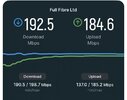There's something in what
@foxhole says about the age of your wireless router.
Quite a while ago, BT were making a big play about their Wi-Fi coverage being the fastest. This was with their new BT Hub router at the time, and it's still relevant today. It was fast. They were running 5 GHz wireless ac / n at the time. However, the range was pants. What their adverts failed to mention was they'd switched off the ability to drop to 2.4 Ghz wireless n where better range was needed. Their wireless routers could do dual channel, but by default they were shipping with it switched off.
You mention glass. Although you and I can see through it, to Wi-Fi it looks the same as a solid wall.
Your ISP might give you a router that is more advanced than the one you have now. Router tech does trickle down, so there's every chance you could receive a dual band router which can run 2.4 and 5 Ghz at the same time. If your present router can run dual bands but it isn't set up then that's something you should look at.
The last time I changed my broadband package it was to go from 35 Meg fibre to the pole to 80 Meg fibre to the property. It made zero difference to the speed of any Wi-Fi in the house.
Like many people, I have a Wi-Fi dead spot near the TV. It's a combination of the range, the proximity of a wall, and the fact that the Fire TV stick is buried behind the metal box that is the home cinema surround amp and it makes a fantastic Wi-Fi barrier.

I was using a pretty good wireless router that I'd bought to improve over the ISP 'free' router. It was a Netgear Nighthawk, but even that couldn't fix the range issues around the TV area.
The new router from the ISP was the same. Not too surprising, the Netgear was good, so it would have been a surprise if an ISP router could better it. I knew a wireless repeater wasn't going to improve things enough. Anything using just wireless to extend the range also drops the Wi-Fi speed by half.
What I did to fix the connectivity was to run an Ethernet cable from the router to the back of the TV. This wasn't a short lead. It goes from the router at the back of the house, up into the loft, then to the front of the house and into the living room via the same hole as the aerial and Sky cables. This was outdoor-rated Cat5e which does gigabit speeds, so it is way faster than my current broadband service. That cable is quite thin too. It's about the diameter of a decent phone-charger lead.
From the end of this cable I run an 8-port gigabit speed network switch. The Fire TV stick has an on-the-go cable attached for a hardwired network connection. The TV, the AV receiver, a 4K Blu-ray player, and the Sky box all connect, too. If I wanted to improve Wi-Fi in this part of the house, I could add a wireless access point. This would take the gigabit network speed and then make it available as a dual-band Wi-Fi signal up to the maximum speeds the device allowed.
I know the idea of running cable gives some people nightmares. It is the right answer though rather than praying for a Wi-Fi miracle.



